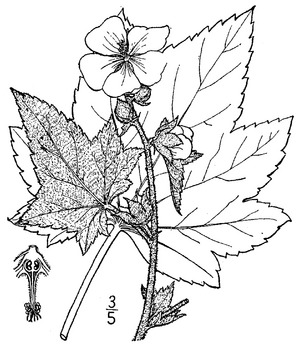Kankakee mallow facts for kids
Quick facts for kids Kankakee mallow |
|
|---|---|
 |
|
| Kankakee mallow | |
| Scientific classification | |
| Genus: |
Iliamna
|
| Species: |
remota
|
| Synonyms | |
|
|
The Iliamna remota, also known as the Kankakee mallow, is a beautiful flowering plant. It belongs to the mallow family. This plant is very special because it is an endangered species. This means there are very few of them left in the world.
The Kankakee mallow grows only in one place. This unique spot is Langham Island, which is about 700-metre-long (2,300 ft). Langham Island is located in Kankakee River State Park, in the state of Illinois, USA. This makes the plant endemic to that island, meaning it's found nowhere else naturally.
Contents
What is the Kankakee Mallow Like?
The Kankakee mallow is a herbaceous plant. This means it has soft, green stems, not woody ones like a tree. It is also a perennial plant, which means it lives for many years. These plants can grow quite tall, from 1 to 2.5 meters (about 3 to 8 feet).
Its stems are greyish-green and covered in tiny hairs. The leaves are arranged in an "alternate" pattern along the stem. They are shaped a bit like a hand with several "fingers" or lobes. The top side of the leaves is smooth and medium green. The underside is greyish-green and also hairy.
Flowers and Roots
The Kankakee mallow has large, pretty flowers. They grow where the leaves meet the stem. You might see them alone or in small groups of up to three flowers. Their colors can range from white to a soft lavender.
A single plant can have two to eight stems growing from its base, called the root crown. The roots themselves usually don't go very deep. However, they form long, thick, and tangled networks underground.
Life Cycle of the Kankakee Mallow
The Kankakee mallow usually starts growing in March. Its beautiful flowers bloom in July or August. The seeds are then spread in September. Sometimes, new groups of plants can grow from underground stems called rhizomes.
Why is the Kankakee Mallow Special?
Scientists have studied the Kankakee mallow's classification for a long time. There are other similar plants in the Iliamna group that grow in Illinois and nearby states. These include Iliamna rivularis and Iliamna corei.
In 1906, a scientist named Edward Lee Greene first officially classified the Kankakee mallow. He said it was different from Iliamna rivularis because of its flower parts. Later studies, including one in 2000 that looked at the plant's DNA, confirmed that the Kankakee mallow is indeed its own unique species.
History of the Kankakee Mallow
The Kankakee mallow was first officially recorded on June 29, 1872. A person named Ellsworth Jerome Hill found it on Langham Island. At that time, the island was called Altorf Island.
Becoming an Endangered Species
In 1966, Langham Island became an official nature preserve. Because the Kankakee mallow only grew on this one island and had a small population, it was put on Illinois's endangered species list in 1980.
In 1981, a survey found about 109 flowering stems in one group of plants on the island. Just two years later, in 1983, that same group had shrunk to only 49 stems. Overall, there were only about 180 stems left in five different groups on the island.
Helping the Kankakee Mallow Survive
A botanist named John Schwegman created a plan to help the Kankakee mallow. His plan involved clearing out other plants on the island. These other plants were blocking sunlight from reaching the mallow. He used special chemicals and controlled burns (carefully set fires) to do this. They also planned to check the mallow population every year.
This plan started in 1984 and continued for 19 years. In 2001, they found that burning the surrounding brush really helped new mallow seedlings grow. In one area, after a burn, about 3,500 new seedlings started to germinate (sprout).
Thanks to these efforts, the average number of mallow stems on the island grew from 180 to 1,646 by 2002! A big part of this increase happened right after the brush burning.
Challenges and Recovery
However, after 2003, no more brush burnings were done for a long time. The plants were not managed or watched over as much. By 2005, only 1,074 stems were found. By 2014, almost all the mallow plants on the island had disappeared. Not a single stem could be found! This happened because invasive plants (plants that take over an area) had grown all over the island.
Thankfully, a local group called "Friends of Langham Island" stepped in. In the winter of 2014, they started controlled burns again to clear out the invasive plants. The next August, in 2015, they were thrilled to see Kankakee mallow growing on the island once more! The fires had helped the mallow seeds sprout.
A State Flower?
In 2015, a campaign began to make the Kankakee mallow the state flower of Illinois. The current state flower, the violet, is also the state flower for three other states. People thought it would be nice for Illinois to have a unique state flower. Representative Kate Cloonen has supported the idea of making this happen.

